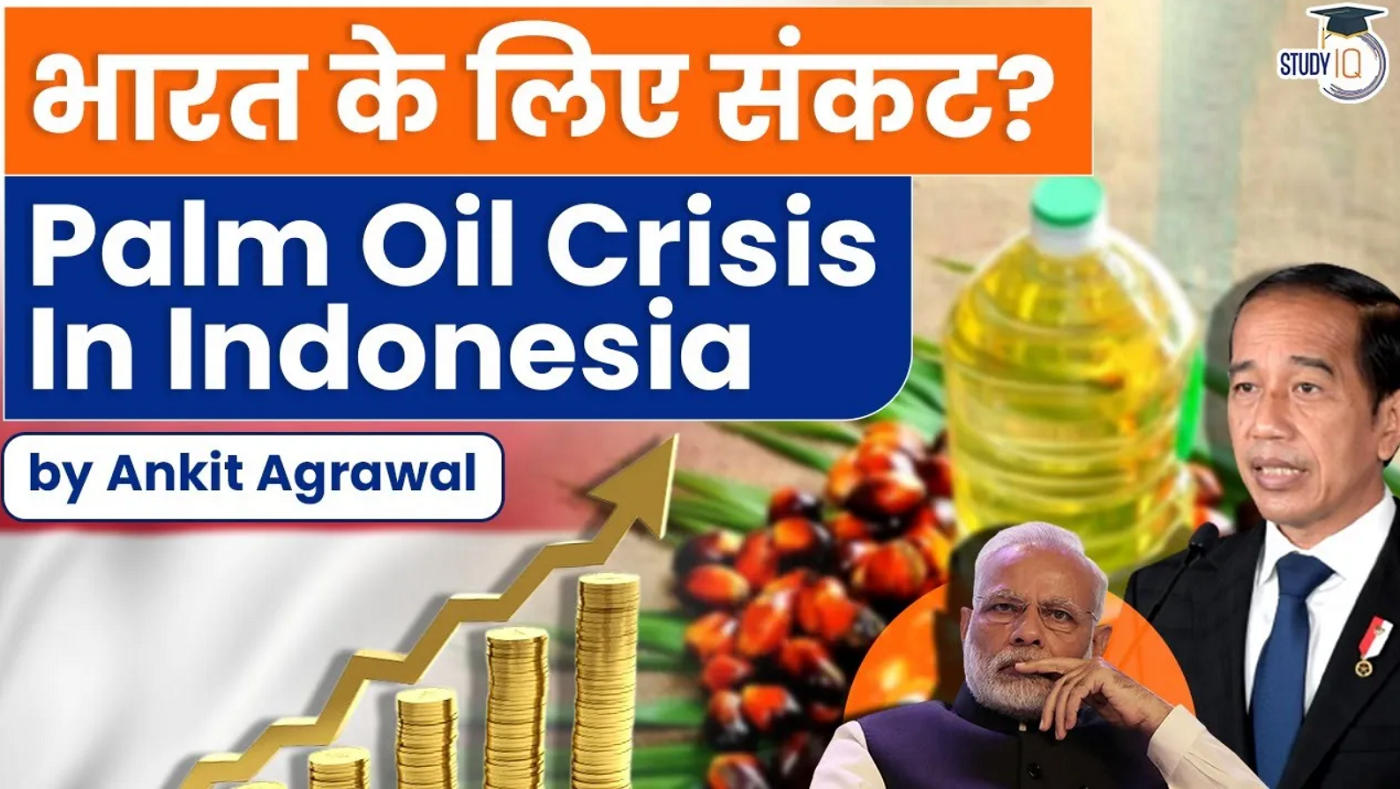Table of Contents

What has happened?
- It’s rare for any country that is the largest producer and exporter of a product to experience domestic shortages of the same product — so much so as to force its government to introduce price controls and curbs on shipments.
- But that is precisely the story of Indonesia vis-à-vis palm oil. The US Department of Agriculture (USDA) has estimated the archipelago’s palm oil production for 2021-22 (October-September) at 45.5 million tonnes (mt).
- That’s almost 60% of the total global output and way ahead of the next bigger producer: Malaysia (18.7 mt).
- It is also the world’s No. 1 exporter of the commodity, at 29 mt, followed by Malaysia (16.22 mt).
- Yet, the country has seen domestic prices of branded cooking oil spiral, from around 14,000 Indonesian rupiah (IDR) to 22,000 IDR per litre between March 2021 and March 2022.
- On February 1, the Indonesian government imposed a ceiling on retail prices.
- These were fixed at 14,000 IDR for “premium” 1-, 2- or 5-litre packs and at 13,500 IDR for “simple” minimally-labelled below-1-litre containers.
- The price caps, however, led to the product disappearing from supermarket shelves, amid reports of hoarding and consumers standing in long queues for hours to get a pack or two (14,000 IDR is less than $1 or Rs 74).
Curbs on export
- Besides domestic price controls, the government also made it compulsory for exporters to sell 20% of their planned shipments in the domestic market.
- These were again at predetermined prices of 9,300 IDR per kg for crude palm oil (CPO) and 10,300 IDR per kg for RBD (refined, bleached, deodourised) palmolein.
- The domestic market obligation was further raised to 30% with effect from March 10.
Reasons for the crisis
- There are two possible reasons.
- The first has to do supply disruptions — manmade and natural — in other cooking oils, especially sunflower and soyabean.
- Ukraine and Russia together account for nearly 80% of the global trade in sunflower oil, quite comparable to the 90% share of Indonesia and Malaysia in palm.
- Russia’s invasion of Ukraine on February 24, which is ongoing, has resulted in port closures and exporters avoiding Black Sea shipping routes.
- Sanctions against Russia have further curtailed trade in sunflower oil, the world’s third most exported vegetable oil (12.17 mt, according to USDA estimates for 2021-22) after palm (49.63 mt) and soyabean (12.39 mt).

- Soyabean oil, too, is facing supply issues due to dry weather in South America.
- The USDA has projected the combined soyabean output of Brazil, Argentina and Paraguay for 2021-22 to fall by 9.4%, translating into the continent’s lowest harvest in six years.
- Supply tightness in sunflower and soyabean — from war and drought, respectively — has, in turn, transmitted to palm oil.
Diversion of palm oil
- The second factor is linked to petroleum, more specifically the use of palm oil as a bio-fuel.
- The Indonesian government has, since 2020, made 30% blending of diesel with palm oil mandatory as part of a plan to slash fossil fuel imports.
- The country’s domestic consumption of palm oil is forecast at 17.1 mt, of which 7.5 mt is for bio-diesel and the balance 9.6 mt towards household and other use.
- “Palm oil getting increasingly diverted for bio-diesel is leaving less quantity available, both for the domestic cooking oil and export market,” said B V Mehta, executive director of the Mumbai- based Solvent Extractors’ Association of India.
- Such diversion has become all the more attractive with Brent crude prices hardening post the Ukrainian war — to a closing high of $127.98 per barrel on March 8 and staying elevated at $100-plus levels.
Impact on India
- India is the world’s biggest vegetable oils importer.
- Out of its annual imports of 14-15 mt, the lion’s share is of palm oil (8-9 mt), followed by soyabean (3-3.5 mt) and sunflower (2.5).
- Indonesia has been India’s top supplier of palm oil, though it was overtaken by Malaysia in 2021-22.

- On March 16-17, the Indonesian government lifted its retail price caps on palm oil along with the 30% domestic market sale obligation on exporters.
- At the same time, it levied a progressive tax on exports, linked to a reference price for CPO.
- These rates range from $175 per tonne (when the reference export price is $1,000-1,050) to $375 (when prices are above $1,500).
- The restrictions on exports, even in the form of levy as well as its ambitious bio-fuel programme, The bigger importer India – will have to get used to lower supplies from Indonesia.
- Meanwhile, import prices of edible oils have eased from their last month peaks, although higher than one year back.
- That should provide some relief, both for households and industrial consumers (including soap and cosmetic makers) in India.
Q) Approximately what fraction of India’s total edible oil demand is met through imports?
- 20%
- 30%
- 50%
- 60%
Latest Burning Issues | Free PDF

























 WhatsApp
WhatsApp